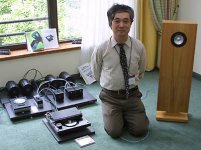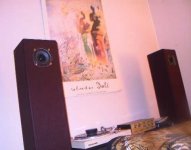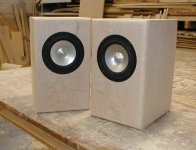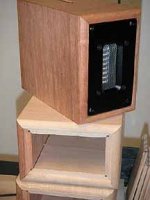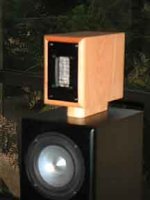Depends on your room size.
I have 15 W JHL amp and pair of Jordans (+ sub) in 18 m2 room and they can go as loud as to start disturbing my neighbors - so pretty loud. But it is always good to have more dynamic headroom in the form of bigger amp or more sensitive speakers.
By the way I tried out the Robert’s crossover this weekend. Didn’t have enough time to go trough much of the different material but for now I have left with kind of mixed feelings. Highs are very good as always with Esg2 but it seems that some midrange glove is lacking compared to single Jordan without crossover. Although I must note here that my speakers have a wider baffle and sealed box for JX92S and Esg2 is supported by same wide baffle, hence maybe different diffraction patterns for drivers and the crossover needs more tuning.
Argo
I have 15 W JHL amp and pair of Jordans (+ sub) in 18 m2 room and they can go as loud as to start disturbing my neighbors - so pretty loud. But it is always good to have more dynamic headroom in the form of bigger amp or more sensitive speakers.
By the way I tried out the Robert’s crossover this weekend. Didn’t have enough time to go trough much of the different material but for now I have left with kind of mixed feelings. Highs are very good as always with Esg2 but it seems that some midrange glove is lacking compared to single Jordan without crossover. Although I must note here that my speakers have a wider baffle and sealed box for JX92S and Esg2 is supported by same wide baffle, hence maybe different diffraction patterns for drivers and the crossover needs more tuning.
Argo
I found a review on the Jordan 92S TL at http://www.highendaudio.com/essence.htm .
The konus-audio site has been down for a long time now, however I have downloaded just about every pic of this speaker. I have about 14 pics. Posting them all would be a mistake because it would slow down this thread for people using slooow phone line modems, so I’m going to post about two, in order to encourage others to post there pics.
The konus-audio site has been down for a long time now, however I have downloaded just about every pic of this speaker. I have about 14 pics. Posting them all would be a mistake because it would slow down this thread for people using slooow phone line modems, so I’m going to post about two, in order to encourage others to post there pics.
Attachments
I agree with argo that a single JX92S can play very loud, if restricted. That is, I only use it from 100 Hz up to approx 5 kHz. As I mentioned, this produced levels of 100 dB continuous at 2 M from the speakers (a pair running). This is VERY loud in our room, which is 20 x 26 feet with a vaulted ceiling that goes from 8 feet to 16 feet. If you choose not to add a sub and a high pass filter for the Jordan, it will not play this loud. Remember, my goal (maybe not yours) was to use single drivers for each range. (As an aside, besides the Quad 988, another speaker that I've heard and liked are the Vandersteen's 3 and 5 series: single drivers, time-aligned, that do play loud.)
As for amp power, the more the better is true with almost all speakers. Having dynamic reserve is better: more control of the drivers and the ability to re-create dynamics. (Amps are like car engines, a 180 HP engine will take you anyplace just as well as the 400 HP in the same chassis, you just can't be driven bad in your seat as much.) I use 350 W monoblocks (into 8 ohms), but I've tried 30 W aleph-like units and they sound very good with these speakers.
As for the x/o, what I put together gets flat freq response, flat warble response and sounds like my Quad 988. If you change the x/o, the presentation definitely will change, and that's fine if it creates the sound you prefer. These subtleties are like discussing which varietal of wine one prefers. There is no absolute, just opinions and feelings. (That's not to say you can't taste a wine that gone bad, just as some speakers can be made worse.) Anyhow, if you compare the 92S + ESg2 to the 92S alone, as I mentioned near the start of this thread, the sound is rather bright and on measurement, showed a midrange peak. The other issue is that the 92S has an upper frequency response that is primarily generated by cone break-up. Look at the response and waterfall plots on the Jordan site. This is not some abstract ideal speaker, but displays cone break like all other 4 to 5" cone drivers. To get a proper balance to the sound, these must be removed.
Cabinet arguments aside, the real world doesn't quite measure and respond like theory: baffles need to get quite large before measurements radically change. Moving your head about the listening field, or slightly pointing the speakers at a different angle will produce much greater changes. So I'd advise would be builders not to get too caught up in baffles that vary by an inch or two.
What I found in listening tests while working on the x/o is that most music could sound good with most x/o variations. However, it was only a few x/o variations that could be tolerated with virtually all styles music. An example: before I removed the broad midrange peak, solo voice, quartets and small jazz groups, as well as solo violin, sounded pretty good. When the jazz group became a band, or the quartet an orchestra, the sound was too bright and not airy. Varying the L-pad and the capacitor also alter the sound. Pick your poison.
The point of this post is that IF you start with one of Carolina Audio's Jordan boxes and IF you add an ESg2, this x/o is a very reliable starting point. Any other combination is simply starting all over, but that's fine too.
As for amp power, the more the better is true with almost all speakers. Having dynamic reserve is better: more control of the drivers and the ability to re-create dynamics. (Amps are like car engines, a 180 HP engine will take you anyplace just as well as the 400 HP in the same chassis, you just can't be driven bad in your seat as much.) I use 350 W monoblocks (into 8 ohms), but I've tried 30 W aleph-like units and they sound very good with these speakers.
As for the x/o, what I put together gets flat freq response, flat warble response and sounds like my Quad 988. If you change the x/o, the presentation definitely will change, and that's fine if it creates the sound you prefer. These subtleties are like discussing which varietal of wine one prefers. There is no absolute, just opinions and feelings. (That's not to say you can't taste a wine that gone bad, just as some speakers can be made worse.) Anyhow, if you compare the 92S + ESg2 to the 92S alone, as I mentioned near the start of this thread, the sound is rather bright and on measurement, showed a midrange peak. The other issue is that the 92S has an upper frequency response that is primarily generated by cone break-up. Look at the response and waterfall plots on the Jordan site. This is not some abstract ideal speaker, but displays cone break like all other 4 to 5" cone drivers. To get a proper balance to the sound, these must be removed.
Cabinet arguments aside, the real world doesn't quite measure and respond like theory: baffles need to get quite large before measurements radically change. Moving your head about the listening field, or slightly pointing the speakers at a different angle will produce much greater changes. So I'd advise would be builders not to get too caught up in baffles that vary by an inch or two.
What I found in listening tests while working on the x/o is that most music could sound good with most x/o variations. However, it was only a few x/o variations that could be tolerated with virtually all styles music. An example: before I removed the broad midrange peak, solo voice, quartets and small jazz groups, as well as solo violin, sounded pretty good. When the jazz group became a band, or the quartet an orchestra, the sound was too bright and not airy. Varying the L-pad and the capacitor also alter the sound. Pick your poison.
The point of this post is that IF you start with one of Carolina Audio's Jordan boxes and IF you add an ESg2, this x/o is a very reliable starting point. Any other combination is simply starting all over, but that's fine too.
LBHajdu,
Thanks for the post. I hope to get some photos of my speakers up this weekend.
I just finished cutting and routing the lumber for the cabinets for the ESg2 ribbons. The wood is a combination of beech and spanish cedar (they smell good too). Only problem is they require a router table and a sliding compound mitre saw. I still need to glue them up. (Ronnie at Carolina should have the plans and be able to supply them in black.)
Regards, robert
Thanks for the post. I hope to get some photos of my speakers up this weekend.
I just finished cutting and routing the lumber for the cabinets for the ESg2 ribbons. The wood is a combination of beech and spanish cedar (they smell good too). Only problem is they require a router table and a sliding compound mitre saw. I still need to glue them up. (Ronnie at Carolina should have the plans and be able to supply them in black.)
Regards, robert
Hi Navin and everybody: If You examine commercial 2-way speaker XO schematics (usual XO-point from about 1600Hz - 4000Hz) You`ll see that exactly this is done in almost every of this kind of designs. Mostly You`ll find there a 6dB lowpass whose coil is much larger than it would be expected from the "book-formulars" for the corresponding speaker impedance. The (calculated) lowpass XO-point for those mostly lay around 500Hz while the tweeter is crossed 12dB (sometimes 18dB) at its normal frequency around 2kHz and up whitout getting any kind of midrange notch in the frequency response.what i found too was something similar. while i did not know about baffle step response at that time I found that as I increase the series inductor in the XO the sound became more listenable. I had no measurements to define why and what of this phenomenon.The Tweeter if I remember correctly was XOed at about 6k (1st order) and the woofer if I remember sounded better and better as i XOed it lower I thinkI finally stopped at 1.2k or there abouts out of fear that the hole between the woofer and tweeter would get to big.
Though You haven`t verfied the correctness of the procedure (increasing lowpass coil value I mean) by actual measurements You have done exactly the right thing intuitively
BTW: This brings the efficiency pretty down below the nice numbers in the data sheets for the woofers which usually are measured either in larger baffles and/or at higher frequencies. Therefore this have to be taken into account while designing the tweeters L-pad and is responsible that a let´s say 90dB woofer + 90dB tweeter (from the datasheets) won`t match well to 90dB overall but much lower (usually 4-7 dB`s down).
cocolino,
I did state at the start of this thread that I need measurements (impulse, step response, frequency, impedance plots, along with in-room warble tone frequency measurements). The x/o was not simply intuitive. This is also how I arrived at how much to physically offset the ribbon (hopefully this will be clear from later photos).
I used the DLSA Pro Measuring system. I refined the x/o between measurements and listening tests. As I mentioned, I had in my house a pair of Quad 988 for reference that I switched back and forth. In fact, the JX92S-ESg2 measure flatter than the 988 (with an almost identical step response), play louder, image as well, are considerably smaller, don't overload my room with dipole radiation, and are much less expensive to boot.
Regards, Robert
I did state at the start of this thread that I need measurements (impulse, step response, frequency, impedance plots, along with in-room warble tone frequency measurements). The x/o was not simply intuitive. This is also how I arrived at how much to physically offset the ribbon (hopefully this will be clear from later photos).
I used the DLSA Pro Measuring system. I refined the x/o between measurements and listening tests. As I mentioned, I had in my house a pair of Quad 988 for reference that I switched back and forth. In fact, the JX92S-ESg2 measure flatter than the 988 (with an almost identical step response), play louder, image as well, are considerably smaller, don't overload my room with dipole radiation, and are much less expensive to boot.
Regards, Robert
navin,
I hope to get some photos up soon. I'll post some construction photos of the ESg2 mini-cabinets, along with photos of parts, etc.
As far as SPL goes, I measured 100 dB continuous at 2 M, this is playing music, not a test signal. This was really loud. With 350W into 8 ohms and the speakers being essentially a 5 ohm load, I have 500 W or so of power per channel. This means that music peaks/transients, which I was not measuring, are probably on the order of 6 to 12 dB greater. I'm not sure how loud you wish to play music, but in our large room this is too much for regular listening.
Sounds over 110 dB continuous are absolutely dangerous for hearing, so unless you want serious hearing loss as you get older, I wouldn't normally listen to music above 100 dB continuous. (Keep in mind that most men have a 6 dB upper freq loss by age 50 and by mid-60s are typically down 20 dB above 5 kHz; these are from various medical studies that I've read.)
regards, Robert
I hope to get some photos up soon. I'll post some construction photos of the ESg2 mini-cabinets, along with photos of parts, etc.
As far as SPL goes, I measured 100 dB continuous at 2 M, this is playing music, not a test signal. This was really loud. With 350W into 8 ohms and the speakers being essentially a 5 ohm load, I have 500 W or so of power per channel. This means that music peaks/transients, which I was not measuring, are probably on the order of 6 to 12 dB greater. I'm not sure how loud you wish to play music, but in our large room this is too much for regular listening.
Sounds over 110 dB continuous are absolutely dangerous for hearing, so unless you want serious hearing loss as you get older, I wouldn't normally listen to music above 100 dB continuous. (Keep in mind that most men have a 6 dB upper freq loss by age 50 and by mid-60s are typically down 20 dB above 5 kHz; these are from various medical studies that I've read.)
regards, Robert
I have a pair of Jordan 92Ses. I will be using them with a tweeter also. I bought a pair of Neo3PDRs to match with them, but I really didn't like how they measured. I am trying to find a better tweeter to suite them. I like planars but most are too expensive and not shielded. The new shielded Vifa XT tweeter looks like a good canidate, any thoughts on that tweeter? Or any other shield tweeter suggestions?
Thanks,
Rob
Thanks,
Rob
Digi,
Interesting you commented about the Neo3PDR. I actually tried the Neo3PDR-FP first, before the ESg2 ribbons, and didn't mention this fact in my initial posts. They did measure rather odd, yet sounded better with the JX92S than the JX92S by itself; but something seemed wrong. I tried removing the rear chamber, various x/o schemes, and finally gave up. After then using the ESg2, I found these to have better sound quality than the Neo3PDR, and easier to get good measurements.
I did get, however, a good mix of the Neo3PDR-FP ( http://www.partsexpress.com/pe/pshowdetl.cfm?&PartNumber=264-716&DID=7 ) with a Peerless 5" Nomex driver sold at Parts-Express (830337; http://www.partsexpress.com/pe/pshowdetl.cfm?&PartNumber=297-600&DID=7 ). This Peerless is shielded and fairly flat for a midrange. I seem to recall for the 1st order x/o using 3 microfarad cap on the Neo3PDR-FP and a 1 mH on the 5". No resistor was used; I don't remember if I had a zobel on the 5". This combination is not so bad for a computer/spare room audio. The Neo3PDR-FP is about $49 and the 5" Peerless is $36.
Certainly the price is quite a bit more for the ESg2 ($189 at E-Speakers).
Regards, Robert
Interesting you commented about the Neo3PDR. I actually tried the Neo3PDR-FP first, before the ESg2 ribbons, and didn't mention this fact in my initial posts. They did measure rather odd, yet sounded better with the JX92S than the JX92S by itself; but something seemed wrong. I tried removing the rear chamber, various x/o schemes, and finally gave up. After then using the ESg2, I found these to have better sound quality than the Neo3PDR, and easier to get good measurements.
I did get, however, a good mix of the Neo3PDR-FP ( http://www.partsexpress.com/pe/pshowdetl.cfm?&PartNumber=264-716&DID=7 ) with a Peerless 5" Nomex driver sold at Parts-Express (830337; http://www.partsexpress.com/pe/pshowdetl.cfm?&PartNumber=297-600&DID=7 ). This Peerless is shielded and fairly flat for a midrange. I seem to recall for the 1st order x/o using 3 microfarad cap on the Neo3PDR-FP and a 1 mH on the 5". No resistor was used; I don't remember if I had a zobel on the 5". This combination is not so bad for a computer/spare room audio. The Neo3PDR-FP is about $49 and the 5" Peerless is $36.
Certainly the price is quite a bit more for the ESg2 ($189 at E-Speakers).
Regards, Robert
an el-cheapo bipole
hello,
sorry to take the thread down one notch...
i can't afford the jordan's yet, so i built a bipolar transmission line using the RadioShack 40-1354's - great results! the design was done using ML King's excellent TQWT mathcad model (http://www.quarter-wave.com : it really works!)
and the inspiration was from the TL_B speaker project at http://www.t-linespeakers.org
here's one pic. more pix, along with a VERY brief write-up (a longer write-up for www.t-linespeakers.org is in the works) can be found at:
http://web.mit.edu/~sarin/www/tlb.html
thanks -
pradeep
hello,
sorry to take the thread down one notch...
i can't afford the jordan's yet, so i built a bipolar transmission line using the RadioShack 40-1354's - great results! the design was done using ML King's excellent TQWT mathcad model (http://www.quarter-wave.com : it really works!)
and the inspiration was from the TL_B speaker project at http://www.t-linespeakers.org
here's one pic. more pix, along with a VERY brief write-up (a longer write-up for www.t-linespeakers.org is in the works) can be found at:
http://web.mit.edu/~sarin/www/tlb.html
thanks -
pradeep
Attachments
Image is of the cabinets for the ESg2 ribbon. They are 7 inches in depth and have a grove cut in the bottom (top of image) to allow the box to be time-aligned with the Jordan cabinet (next image).
The top box is all spanish cedar, the lower ones are beech and cedar.
The top box is all spanish cedar, the lower ones are beech and cedar.
Attachments
This is the ESg2 ribbon on top of Carolina Audio's JLM style speaker with the JX92S driver. I've only shown the upper portion. The JLM is about 40 inches tall (see their web site for details). I put the ESg2 cabinet on a 1 inch tall pedestal. It looks better than directly mounting it on the JLM box and also better acoustically isolates the drivers.
The box is made of beech on 3 sides; the top is spanish cedar (it smells like an good old humidor). The pedestal is beech. Finish is linseed oil.
This set-up is temporary as these ribbon units will eventually go onto a box that is veneered to create an all wood look. The particular JLM speakers shown here will become my rear channels and another set of ribbon boxes and pedestal will be black to match these boxes.
regards, robert
The box is made of beech on 3 sides; the top is spanish cedar (it smells like an good old humidor). The pedestal is beech. Finish is linseed oil.
This set-up is temporary as these ribbon units will eventually go onto a box that is veneered to create an all wood look. The particular JLM speakers shown here will become my rear channels and another set of ribbon boxes and pedestal will be black to match these boxes.
regards, robert
Attachments
Well, they're not completely temporary. These finished boxes will be moved to the top of the new front channel cabinets, which are not yet ready. The black painted ribbon boxes are also not ready. Therefore, I'm using a mixed of black paint/wood.
My previous temporary, which I didn't show, was the ribbon perched on foam with wires and caps suspeneded in air. My family puts up with this for several weeks...
The boxes are easily removed from the pedestals. The pedestals are screwed to the cabinet top via 4 hidden dry-wall screws. So this too can be later removed and replaced with a black painted pedestal. (There is a 1/2" hole in the pedestal to allow wires to pass through from the inside of the JLM cabinet to the ribbon box.)
My previous temporary, which I didn't show, was the ribbon perched on foam with wires and caps suspeneded in air. My family puts up with this for several weeks...
The boxes are easily removed from the pedestals. The pedestals are screwed to the cabinet top via 4 hidden dry-wall screws. So this too can be later removed and replaced with a black painted pedestal. (There is a 1/2" hole in the pedestal to allow wires to pass through from the inside of the JLM cabinet to the ribbon box.)
Your speaker is something I think I would like to build. I have not built any speaker yet. But, yours seems farily easy. Since, most of the cabinet is off the shelf. My problem is I can not picture what the crossover looks like with out a schematic. When you get the chance could you post a drawing?
Thanks in advance.
Thanks in advance.
- Status
- This old topic is closed. If you want to reopen this topic, contact a moderator using the "Report Post" button.
- Home
- Loudspeakers
- Multi-Way
- Jordan 92S TL + ESg2 ribbon
